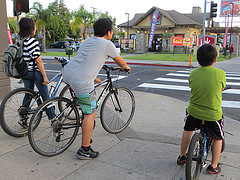
I was excited to read yesterday's pro-bike Los Angeles Times editorial entitled Some bumps in the road on the way to a bike-friendly L.A. The piece calls out Los Angeles City Councilmember Gil Cedillo for stopping the approved North Figueroa bike lanes. The Times supports the "worthwhile objective" of implementing bicycle infrastructure to make "the city safe and hospitable for cyclists... [to] reduce carbon emissions and overall congestion."
Most critically, the Times highlights the regional importance of completing the city-wide bicycle network:
Unless some demonstrable miscalculation was made in the bike plan, or unless there's a real safety issue, individual City Council members should not be tinkering with the plan, which was designed carefully with the whole city in mind. (italics added)
When the city approved its bike plan, it affirmed the importance of bicycling as a valid and worthwhile component of the city's transportation systems. If individual councilmembers opted out of crosswalks, curb-cuts, bus stops, or, heaven forbid, freeway on-ramps, in individual districts, would the mayor and LADOT be so compliant? What if councilmembers start opting out of sewers or flood protection infrastructure? Should councilmembers be nixing regionally interconnected projects? I am glad that the Times doesn't think so.
Unfortunately, even in this welcome editorial, I think that there are a few ways in which the Times misses the mark.
The Times repeats Cedillo's debunked claims that bike lanes somehow delay police and fire vehicles, though it later implies that this might not be a "real safety issue."
Even in a short pro-bike editorial, the Times manages to take the driver's point of view seven times:
- "southbound drivers would spend only an extra 41 to 46 seconds in traffic"
- "Adding bike lanes reduces space for cars and irritates drivers; that's undeniable."
- "luring Angelenos out of their cars"
- "make legions of drivers ... relinquish a fraction of their lanes"
- "No driver wants to be slowed down by even 47 seconds."
- "It's understandable that drivers are frustrated"
- "maybe some drivers will get out of their cars"
It's encouraging that two of the above mentions are about getting drivers out of their cars. But contrast this with bicyclists. The editorial only mentions cyclists twice.
Drivers are important. They will remain a big part of L.A.'s streets for the foreseeable future. Even when the bike plan is fully implemented, cars are slated to continue to receive the lion's share of L.A. road space. LADOT's road diet plan for North Figueroa leaves cars three travel lanes, a turn lane, and two parking lanes: 62 feet out of a 72-foot-wide roadway. Bicycles would get two 5-foot-wide bike lanes.
Isn't it about time that the Times stops weighing all transportation infrastructure based on how it impacts drivers? Even Caltrans is moving beyond measuring transportation this way.
The Times might take a cue from its own architecture critic Christopher Hawthorne who wrote that "it's time to stop measuring new transit initiative[s] and other changes to the city in terms of how they'll affect [car] traffic." It would be great if the Times editorial writers would support bike plan implementation because bicycle facilities (using Hawthorne's words describing transit benefits) "expand options" and "offer new ways to get around."
The Times' bike plan editorial concludes, stating: "The hope is that over time, those [bike] lanes will begin to fill up."
Memo to the Times: that bike-lane-filling has already begun.
Please look around. L.A.'s streets have long been shared streets. Despite many decades of car-centric, safety-adverse transportation priorities, there are still plenty of transit riders, pedestrians, and, yes, bicyclists getting around on L.A.'s great streets. Hundreds and thousands of us.






